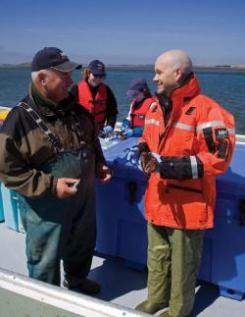
Lobsters are aquatic, yet you can take them out of water and they’ll survive for three days if you keep them moist and cool. They’re invertebrates with an exoskeleton.
They can live to be 100 years old. And the biggest can weigh as much as a five-year-old child.
“They’re so different from everything you learn in vet school, yet they are still animals,” says Jean Lavallée, Clinical Scientist at the AVC Lobster Science Centre.
And they are worth a lot of money, and a lot of jobs. Found along the east coast from North Carolina to Labrador, annual landings in Canada total more than 45,000 tonnes, with a landing value of more than three-quarters of a billion dollars. Over 9,000 people work as lobster fishers. Lobster is the most valuable seafood product in Canada.
Yet Lavallée, who has a graduate degree in lobster health, is one of only three veterinarians in Canada working full-time in lobster health; the other two are Andrea Battison and Spencer Greenwood, also at the AVC Lobster Science Centre.
“Lobster veterinary health is different. It deals with a wild species as opposed to a farmed species, and when you have the responsibility to look after a holding facility, the decisions you make might affect a hundred thousand animals at a time. That’s also a very significant economic pressure to make the right decision.”
Yet, until very recently, there was very little lobster health science anywhere in the world.
“When I first came to AVC, I was down in southwest Nova Scotia—the bigger part of the lobster fishery is there—and I was talking with a few fishermen. One of them looked at me and said, ‘You don’t know what you’re talking about. You’re just a scientist. You think lobsters grow in trees.’ I took that to heart. It made me realize that there was a big gap between science and the industry, and from that day on I realized I needed to pay attention to what the industry was saying. And, in fact, I don’t think there is one day that I don’t learn from them. I love the interaction.”
The industry, he says, is a lot more open to science now. And that is in no small measure a result of his work and that of a dozen research and technical colleagues at the AVC Lobster Science Centre.
“I am a big-picture guy, kind of the field arm. I also go to industry meetings, listen, and bring their comments and suggestions back here to see if we can come up with projects that can address their research needs and priorities.”
Lavallée leads a significant lobster health and quality
monitoring program in southwest Nova Scotia. “We have technicians going out before, during, and after the fishing season to monitor lobster health, hemolymph protein levels, moult stage, and shell hardness, because, in recent years, lobsters have sometimes been softer than they usually are at the start of the fishing season. It doesn’t mean they are sick. It probably means that we are taking the animals closer to the moult when they replace their shells. The aim is to see if we could have a monitoring scheme with enough historical data to better understand this phenomenon, and be in a position to predict and tell the industry a couple weeks before the season starts that we think it’ll be better, similar, or worse than the previous years.
“Our role is not to make management decisions. We see our role as giving the industry and the regulators the science to make their own decisions.”
Lavallée’s epidemiological training also led him to look at risk factors for lobster production losses during holding. A significant proportion of landed lobsters are put in holding tanks for anything from a few days to several months and then will either be processed or shipped live. “Between 10 and15 per cent of those lobsters don’t make it to the consumer, and most of those mortalities happen in holding.
“From a veterinary perspective, this is extremely scary. If you are a chicken producer and you lose 10 per cent of your chickens before they reach the market, the first thing you’re going to do is call your veterinarian. We’re putting together a service unit that is based on a veterinary medicine approach, to visit lobster pounds and test the animals on a regular basis or when mortalities are occurring.
“Another part of this is outreach—trying to educate the industry. We’ve been putting science workshops together every year, but also taking the show on the road throughout the region. We’ve been doing it for biologists and industry partners who want to have their staff trained on how to look for weak lobsters, or where in the moult cycle the lobsters are, or how to measure hemolymph proteins.
“This is important to me personally. Half my neighbours are fishermen.At the end of the day, I want to be able to make a difference for the industry.”